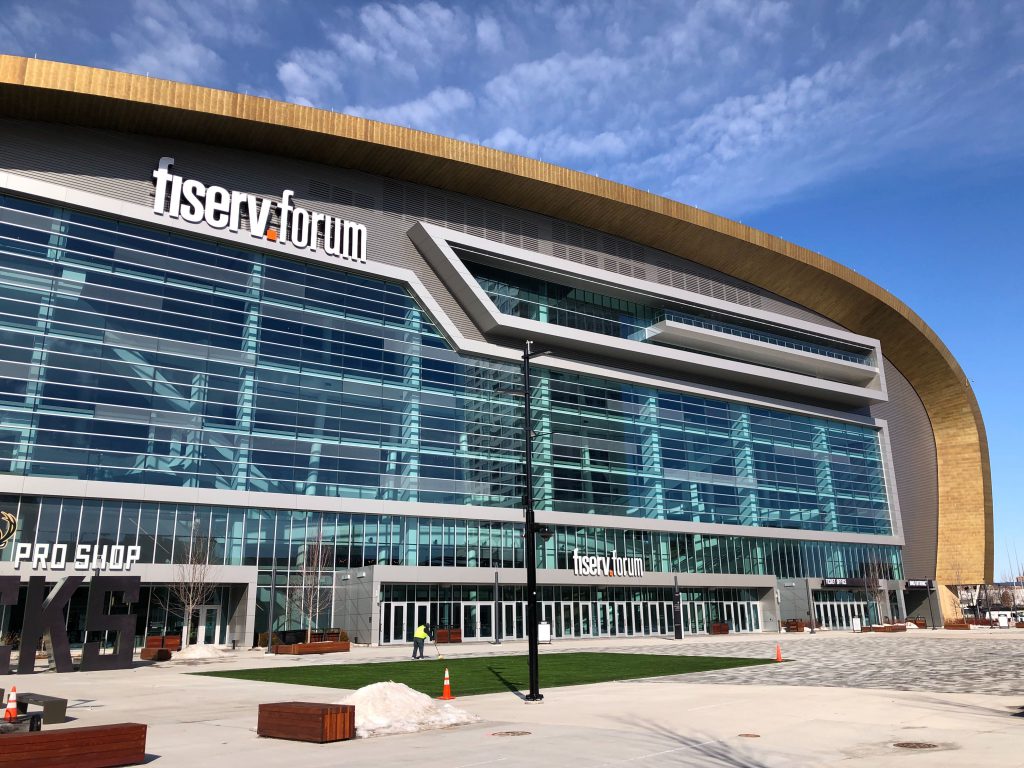Taxpayers Make Bucks, Brewers Rich
Forbes sees huge growth in value of franchises since taxpayer-financed stadiums built.
The latest estimates by Forbes shows the value of the Milwaukee Bucks and Milwaukee Brewers has grown tremendously, increasing the net worth of their mega-wealthy owners, while us taxpayers have grown poorer, paying a continuing subsidy to both teams.
Few pro sports teams in America have seen their value grow like the Milwaukee Bucks. Forbes estimates the value of the franchise is now $1.35 billion, up by $900 million since the team was purchased for $450 million in 2014. (The price was technically $550 million but previous owner Herb Kohl promised to pay $100 million of the team’s contribution to a new arena.)
That’s a stunning three-fold increase in the value of the franchise in just five years.
This increase has helped the Bucks jump from last place in franchise value among the 30 NBA teams, to 22nd place, ahead of eight other teams, including much bigger markets like Detroit and Atlanta.
That’s all the more impressive because the NBA is booming with the value of all franchises enjoying big annual increases. “The NBA is the hottest sports league right now,” Forbes notes. “Investors sniffing around the NBA salivate at the league’s international prospects, with 300 million basketball players in China and annual revenue growing outside the U.S. at a rate in the high teens.”
A key part of a franchise’s value is the venue. The Bucks’ new arena, Fiserv Forum, is a veritable money machine, with its 567-member, all-inclusive BMO Club, which costs each member $12,000 to $70,000 per season, including courtside seats, and its 34 suites which range in price from $225,000 to $450,000 per season. The Bucks also raised the prices for standard seats in the new arena.
The $900 million increase in the franchise’s value will largely enrich the team’s three main owners: Marc Lasry (estimated net worth $1.8 billion), Wes Edens ($1.2 billion) and Jamie Dinan ($2.2 billion).
The Bucks’ owners are credited with paying half the costs of the new $500 million arena, with taxpayers the rest, in typical media accounts. But that leaves out all kinds of other subsidies charged to taxpayers that lower the facility’s cost for the owners: a sales tax exemption on building materials, equipment and supplies to build the arena, a property tax exemption on the arena, a sales tax exemption on luxury suite revenue and all retail sales within the arena, the interest payments on bonds issued to pay for the arena, and various other charges that brings the total bill for taxpayers to at least $800 million as I’ve previously estimated. These are all costs a for-profit business would normally pay, but the billionaires who own the Bucks will never be charged over the likely 30-year life of the arena.
There is, however, one business in town that gets a similar kind of deal: the Milwaukee Brewers, who like the Bucks have gotten rich off the taxpayers.
While it’s not doing quite as spectacularly as the NBA, the MLB is doing very well, thank you. “Baseball is more lucrative than it has ever been because of the continued escalation in the value of the sport’s media rights,” Forbes notes in its latest rundown of the industry. “In November, Fox signed a new seven-year media rights deal with MLB beginning with the 2022 season that is worth almost 50% more than its current eight-year deal with baseball.”
That will add more revenue for the 30 MLB teams that saw an average increase in operating income of 38 percent in 2018, the story noted. “This is our 22nd rendition of MLB valuations, and over that span the average team value has increased at an 11% compound annual rate of growth. Over the same span NBA and NFL team values have increased 13% and 12%, respectively.” Of course, all these teams get big subsidies from the taxpayers, which guarantees that these owners always make a killing
Take the Brewers. Owner Mark Attanasio bought the team for $223 million in 2004, and the current value, according to Forbes, is now $1.175 billion. That’s a five-fold growth in value in 15 years. That increase has helped the team, which ranked last in value before Miller Park was built, jump to 25th in value, ahead of six franchises including those in bigger markets like Miami and Cleveland.
The total bill to the taxpayers for Miller Park is in excess of $1 billion as I once estimated in a story for Milwaukee Magazine.
Yet as generous as the citizenry are to Attanasio’s business, they also are over performing as customers, it seems. The Brewers rank second in revenue generated per fan, behind only the San Francisco Giants, as another Forbes analysis shows.
What’s happening with both teams — and all major league teams — is a huge transfer of wealth from average Americans to some of the wealthiest people on earth. The sole exception is the community-owned Green Bay Packers. And this massive income transfer then creates sports palaces that separate fans by income classes, not just reinforcing but celebrating the wealth gap now found across America.
Is there any bright spot to this dismal tale of plundered taxpayers? Yes.
Both the Bucks and Brewers owners have delivered what we were promised: competitive teams. Indeed, Milwaukee may end up with the most valuable player in both baseball (Christian Yelich) and basketball (Giannis Antetokounmpo). Both teams have made shrewd choices of coaches and general managers and have run their businesses smartly, and in the Bucks’ case, with particular flair. Major League sports owners may be the robber barons of the 21st century, but some are smarter than others, and Milwaukee at least appears to be lucky in that respect.
If you think stories like this are important, become a member of Urban Milwaukee and help support real independent journalism. Plus you get some cool added benefits, all detailed here.
More about the Miller Park Stadium Tax
- Murphy’s Law: Why Attanasio Has Never Developed Around Brewers Stadium - Bruce Murphy - Nov 25th, 2025
- See Brewers’ Options To Develop Land Around Their Stadium - Jeramey Jannene - Nov 12th, 2025
- Stadium Authority Seeks Study to Redevelop Brewers Parking Lots - Jeramey Jannene - May 28th, 2025
- $54.9 Million in Upgrades Approved for Brewers Stadium - Evan Casey - Jan 28th, 2025
- MKE County: Brewers Ballpark Subsidy Stings County Budget - Graham Kilmer - Jul 28th, 2024
- Governor Signs Brewers Subsidy Agreement At American Family Field - Evan Casey - Dec 5th, 2023
- Gov. Evers Signs Bills to Keep Milwaukee Brewers, Major League Baseball in Wisconsin Through 2050 - Gov. Tony Evers - Dec 5th, 2023
- Council, Mayor Bickered On Brewers Deal - Jeramey Jannene - Nov 29th, 2023
- Brewers Stadium Deal Passes the Legislature - Shawn Johnson - Nov 14th, 2023
- County Executive David Crowley’s Statement on Bipartisan Bill to Keep Brewers in Milwaukee - David Crowley - Nov 14th, 2023
Read more about Miller Park Stadium Tax here
More about the New Bucks Arena
- Murphy’s Law: Bucks Violating Promises on Unions? - Bruce Murphy - Jun 5th, 2025
- Back in the News: Bucks Owners Continue to Cash In - Bruce Murphy - Nov 28th, 2022
- Murphy’s Law: Bucks Subsidy An Issue in US Senate Race - Bruce Murphy - May 9th, 2022
- Murphy’s Law: Bucks Franchise Worth $1.86 Billion - Bruce Murphy - Jan 25th, 2021
- Op Ed: County Parks Lost Funding to Bucks Arena - Patricia Jursik - Jul 7th, 2020
- Eyes on Milwaukee: Fiserv Forum Workers to Get $15/Hour - Jeramey Jannene - Jan 29th, 2020
- Eyes on Milwaukee: Bucks Beat Hiring Targets on Fiserv Forum - Jeramey Jannene - Nov 20th, 2019
- Murphy’s Law: Taxpayers Make Bucks, Brewers Rich - Bruce Murphy - Apr 16th, 2019
- Eyes on Milwaukee: Bucks Unveil Master Plan for Park East - Jeramey Jannene - Mar 15th, 2019
- Eyes on Milwaukee: Bucks Plan Massive Arena Signs - Jeramey Jannene - Feb 12th, 2019
Read more about New Bucks Arena here
Murphy's Law
-
The Last Paycheck of Don Smiley
 Dec 17th, 2025 by Bruce Murphy
Dec 17th, 2025 by Bruce Murphy
-
Top Health Care Exec Paid $25.7 Million
 Dec 16th, 2025 by Bruce Murphy
Dec 16th, 2025 by Bruce Murphy
-
Milwaukee Mayor’s Power in Decline?
 Dec 10th, 2025 by Bruce Murphy
Dec 10th, 2025 by Bruce Murphy





















Wow, and to think that Herb Kohl only paid $18m for the Bucks in 1985. If the team is now worth an estimated $1.35B, that is your basic 7,500 percent increase in value. (Like if I bought a $35k house in 1985 and can somehow sell it today for $2.6m. Maybe in some areas of the country that has happened?)
Socialism for the rich truly is “the cat’s pajamas” for billionaire hoarders of money. For the rest of us, not so good as we get told we can’t have any “free stuff” like socialized health care.
Two aspects of the new stadiums are neglected in this article. First is the spill-over effect: the impact of sports franchises on other businesses. The Brewers are located far from downtown and have a non-existent spatial effect on Milwaukee business, unless you count a few area bars. But the Bucks were designed to rejuvenate downtown and seem to have succeeded. The Entertainment District appears to be flourishing. A city of spectacle is a necessary component of a healthy urban center.
A more important aspect of the sports franchises is uncertain: how do they impact the city of desperation? After all Milwaukee is among the poorest and most segregated cities in the country. How much of that wealth of the franchises will go to alleviate conditions in the city of desperation? I’m not optimistic, but without wealth, there is no hope Milwaukee can ever be a city of justice.
It’s Biblical: The rich get richer. Don’t forget to add this story on Quality of Life to this discussion:
https://urbanmilwaukee.com/2017/06/19/op-ed-county-neglects-parks-and-culture/
There are a number of cities that financed sports venues and are stuck with them when the team decides to leave for more lucrative cities. For sharing the risk of financing a sports venue, what if the State of Wisconsin could have demanded a percentage nov-voting shares of the Bucks if the value of the team went up significantly like it has. The State would have the right to sell their shares to recoup their costs of the Firserv Forum. The owners would still be very well off. But in this era of corporate welfare by the State of Wisconsin, it was not going to happen.
Cities should receive stock in the franchise equal to their subsidy.